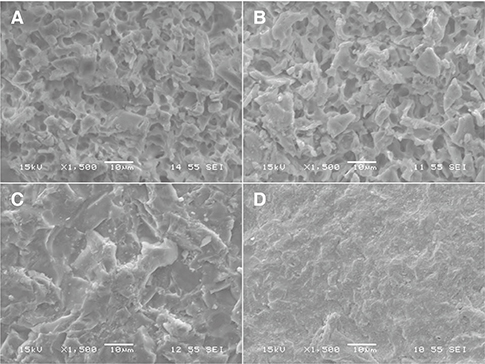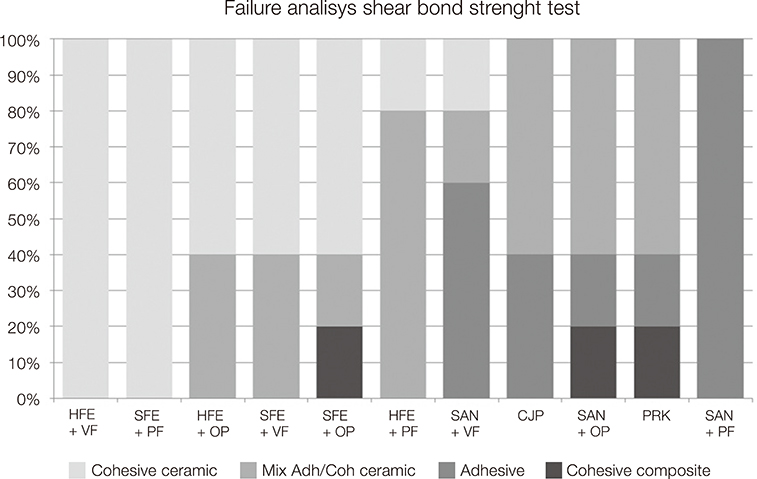J Adv Prosthodont.
2017 Aug;9(4):257-264. 10.4047/jap.2017.9.4.257.
Comparison of traditional and simplified methods for repairing CAD/CAM feldspathic ceramics
- Affiliations
-
- 1Department of Medical Biotechnologies, University of Siena, Siena, Italy. m.carrabba@yahoo.it
- 2University of Portsmouth Dental Academy, Portsmouth, United Kingdom.
- KMID: 2398072
- DOI: http://doi.org/10.4047/jap.2017.9.4.257
Abstract
- PURPOSE
To evaluate the adhesion to CAD/CAM feldspathic blocks by failure analysis and shear bond strength test (SBSt) of different restorative systems and different surface treatments, for purpose of moderate chipping repair.
MATERIALS AND METHODS
A self-adhering flowable composite (Vertise Flow, Kerr) containing bi-functional phosphate monomers and a conventional flowable resin composite (Premise Flow, Kerr) applied with and without adhesive system (Optibond Solo Plus, Kerr) were combined with three different surface treatments (Hydrofluoric Acid Etching, Sandblasting, combination of both) for repairing feldspathic ceramics. Two commercial systems for ceramic repairing were tested as controls (Porcelain Repair Kit, Ultradent, and CoJet System, 3M). SBSt was performed and failure mode was evaluated using a digital microscope. A One-Way ANOVA (Tukey test for post hoc) was applied to the SBSt data and the Fisher's Exact Test was applied to the failure analysis data.
RESULTS
The use of resin systems containing bi-functional phosphate monomers combined with hydrofluoric acid etching of the ceramic surface gave the highest values in terms of bond strength and of more favorable failure modalities.
CONCLUSION
The simplified repairing method based on self-adhering flowable resin combined with the use of hydrofluoric acid etching showed high bond strength values and a favorable failure mode. Repairing of ceramic chipping with a self-adhering flowable resin associated with hydrofluoric acid etching showed high bond strength with a less time consuming and technique-sensitive procedure compared to standard procedure.
Keyword
Figure
Reference
-
1. Kelly JR, Benetti P. Ceramic materials in dentistry: historical evolution and current practice. Aust Dent J. 2011; 56:84–96.2. Kelly JR, Nishimura I, Campbell SD. Ceramics in dentistry: historical roots and current perspectives. J Prosthet Dent. 1996; 75:18–32.3. Tan K, Pjetursson BE, Lang NP, Chan ES. A systematic review of the survival and complication rates of fixed partial dentures (FPDs) after an observation period of at least 5 years. Clin Oral Implants Res. 2004; 15:654–666.4. Sailer I, Pjetursson BE, Zwahlen M, Hämmerle CH. A systematic review of the survival and complication rates of all-ceramic and metal-ceramic reconstructions after an observation period of at least 3 years. Part II: Fixed dental prostheses. Clin Oral Implants Res. 2007; 18:86–96.5. Anusavice KJ. Standardizing failure, success, and survival decisions in clinical studies of ceramic and metal-ceramic fixed dental prostheses. Dent Mater. 2012; 28:102–111.6. Hickel R, Brüshaver K, Ilie N. Repair of restorations-criteria for decision making and clinical recommendations. Dent Mater. 2013; 29:28–50.7. Vita Zahnfabrik. Vitablocs working instructions 1769E. 2012. 05.8. Heintze SD, Rousson V. Survival of zirconia- and metal-supported fixed dental prostheses: a systematic review. Int J Prosthodont. 2010; 23:493–502.9. Burke FJ, Grey NJ. Repair of fractured porcelain units: alternative approaches. Br Dent J. 1994; 176:251–256.10. Kimmich M, Stappert CF. Intraoral treatment of veneering porcelain chipping of fixed dental restorations: a review and clinical application. J Am Dent Assoc. 2013; 144:31–44.11. Reston EG, Filho SC, Arossi G, Cogo RB, Rocha Cdos S, Closs LQ. Repairing ceramic restorations: final solution or alternative procedure? Oper Dent. 2008; 33:461–466.12. Blum IR, Jagger DC, Wilson NH. Defective dental restorations: to repair or not to repair? Part 2: All-ceramics and porcelain fused to metal systems. Dent Update. 2011; 38:150–152. 154–156. 15813. Vichi A, Margvelashvili M, Goracci C, Papacchini F, Ferrari M. Bonding and sealing ability of a new self-adhering flowable composite resin in class I restorations. Clin Oral Investig. 2013; 17:1497–1506.14. Goracci C, Margvelashvili M, Giovannetti A, Vichi A, Ferrari M. Shear bond strength of orthodontic brackets bonded with a new self-adhering flowable resin composite. Clin Oral Investig. 2013; 17:609–617.15. Pashley DH, Carvalho RM, Sano H, Nakajima M, Yoshiyama M, Shono Y, Fernandes CA, Tay F. The microtensile bond test: a review. J Adhes Dent. 1999; 1:299–309.16. Sano H, Shono T, Sonoda H, Takatsu T, Ciucchi B, Carvalho R, Pashley DH. Relationship between surface area for adhesion and tensile bond strength-evaluation of a micro-tensile bond test. Dent Mater. 1994; 10:236–240.17. Perdigão J, Gomes G, Gondo R, Fundingsland JW. In vitro bonding performance of all-in-one adhesives. Part I-microtensile bond strengths. J Adhes Dent. 2006; 8:367–373.18. Sadek FT, Cury AH, Monticelli F, Ferrari M, Cardoso PE. The influence of the cutting speed on bond strength and integrity of microtensile specimens. Dent Mater. 2005; 21:1144–1149.19. Goracci C, Sadek FT, Monticelli F, Cardoso PE, Ferrari M. Influence of substrate, shape, and thickness on microtensile specimens' structural integrity and their measured bond strengths. Dent Mater. 2004; 20:643–654.20. Tylka DF, Stewart GP. Comparison of acidulated phosphate fluoride gel and hydrofluoric acid etchants for porcelain-composite repair. J Prosthet Dent. 1994; 72:121–127.21. Della Bona A, van Noort R. Shear vs. tensile bond strength of resin composite bonded to ceramic. J Dent Res. 1995; 74:1591–1596.22. Ferrari M, Goracci C, Sadek F, Eduardo P, Cardoso C. Microtensile bond strength tests: scanning electron microscopy evaluation of sample integrity before testing. Eur J Oral Sci. 2002; 110:385–391.23. Knight JS, Holmes JR, Bradford H, Lawson C. Shear bond strengths of composite bonded to porcelain using porcelain repair systems. Am J Dent. 2003; 16:252–254.24. van der Vyver PJ, de Wet FA, Botha SJ. Shear bond strength of five porcelain repair systems on cerec porcelain. SADJ. 2005; 60:196–198. 20025. Yoo JY, Yoon HI, Park JM, Park EJ. Porcelain repair - Influence of different systems and surface treatments on resin bond strength. J Adv Prosthodont. 2015; 7:343–348.26. Erdemir U, Sancakli HS, Sancakli E, Eren MM, Ozel S, Yucel T, Yildiz E. Shear bond strength of a new self-adhering flowable composite resin for lithium disilicate-reinforced CAD/CAM ceramic material. J Adv Prosthodont. 2014; 6:434–443.27. Tarib NA, Anuar N, Ahmad M. Shear bond strength of veneering ceramic to coping materials with different pre-surface treatments. J Adv Prosthodont. 2016; 8:339–344.28. Goia TS, Leite FP, Valandro LF, Ozcan M, Bottino MA. Repair bond strength of a resin composite to alumina-reinforced feldspathic ceramic. Int J Prosthodont. 2006; 19:400–402.29. Queiroz JR, Souza RO, Nogueira Junior L Jr, Ozcan M, Bottino MA. Influence of acid-etching and ceramic primers on the repair of a glass ceramic. Gen Dent. 2012; 60:e79–e85.30. Newburg R, Pameijer CH. Composite resins bonded to porcelain with silane solution. J Am Dent Assoc. 1978; 96:288–291.31. Stangel I, Nathanson D, Hsu CS. Shear strength of the composite bond to etched porcelain. J Dent Res. 1987; 66:1460–1465.32. Ozcan M, Valandro LF, Amaral R, Leite F, Bottino MA. Bond strength durability of a resin composite on a reinforced ceramic using various repair systems. Dent Mater. 2009; 25:1477–1483.33. Kumbuloglu O, User A, Toksavul S, Vallittu PK. Intra-oral adhesive systems for ceramic repairs: a comparison. Acta Odontol Scand. 2003; 61:268–272.34. Kussano CM, Bonfante G, Batista JG, Pinto JH. Evaluation of shear bond strength of composite to porcelain according to surface treatment. Braz Dent J. 2003; 14:132–135.35. Vertise Flow Technical Bulletin, Kerr Corporation Lit. No. 34929B. Available from https://embed.widencdn.net/download/kavokerr/4knq7qig7c/vertiseflow_techbulletin_34929b.pdf?u=18sth1.36. Addison O, Marquis PM, Fleming GJ. Adhesive luting of all-ceramic restorations-the impact of cementation variables and short-term water storage on the strength of a feldspathic dental ceramic. J Adhes Dent. 2008; 10:285–293.37. Timokhin AR, Komarova LA. Chemical reaction of ammonium bifluoride with quartz glass. Glass Ceram. 1985; 42:267–269.38. Yen TW, Blackman RB, Baez RJ. Effect of acid etching on the flexural strength of a feldspathic porcelain and a castable glass ceramic. J Prosthet Dent. 1993; 70:224–233.
- Full Text Links
- Actions
-
Cited
- CITED
-
- Close
- Share
- Similar articles
-
- On the marginal fidelity of all-ceramic core using CAD/CAM system
- In vitro evaluation of fracture strength of zirconia restoration veneered with various ceramic materials
- Comparative fracture strength analysis of Lava and Digident CAD/CAM zirconia ceramic crowns
- The effects of different polishing techniques on the staining resistance of CAD/CAM resin-ceramics
- Flexural strength and microstructure of two lithium disilicate glass ceramics for CAD/CAM restoration in the dental clinic



